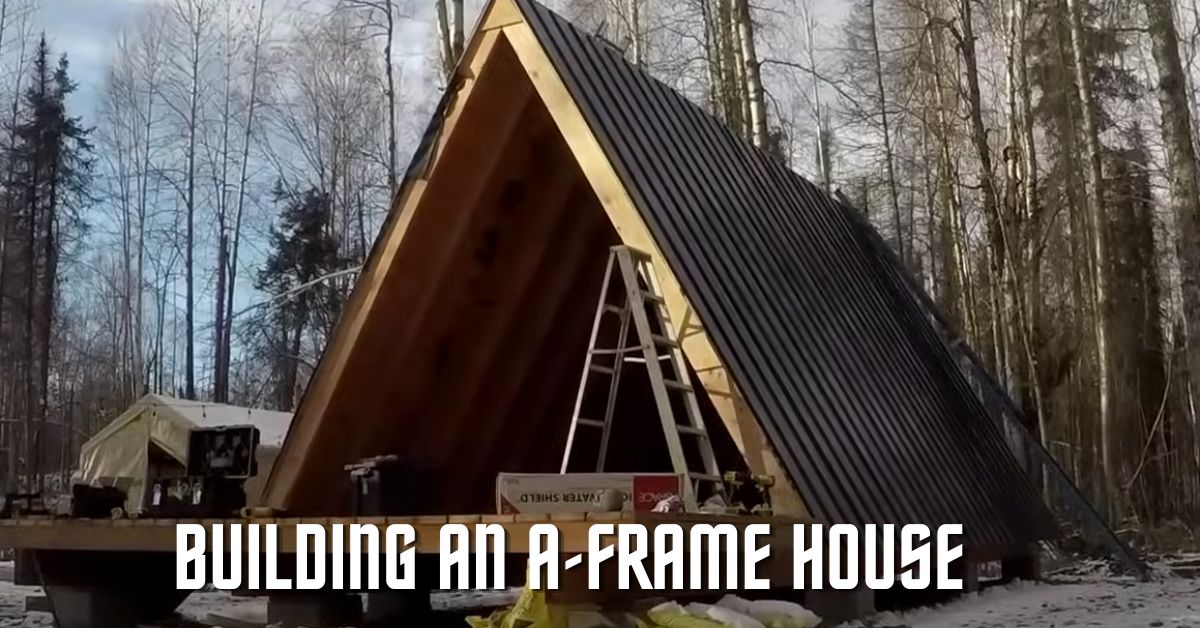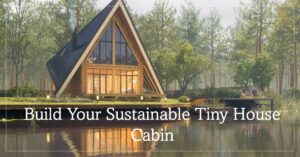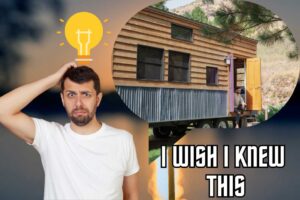
Ever wish you could escape to your own little cabin – one that’s unique, affordable, and a total DIY adventure? A-frame tiny houses are just that! Think charming, surprisingly solid, and way more doable than you imagine.
Does it sound a little ambitious? That’s part of the fun! We’ll show you how to find the perfect build site and make that iconic A-shape feel like home.
Mistakes are part of the learning process, and the result will be a space completely yours.
If you’ve got that itch to build something unique, an A-frame house might be the perfect adventure. Don’t worry if you’re new to DIY – with the right guidance and determination, you can make this happen.
Pre-Build Essentials: Getting Ready for Adventure
Okay, you’ve got the A-frame dream taking shape in your mind. That’s awesome! But before you grab a hammer, there’s some less-glamorous-but-super-important stuff to figure out.
Finding Your Slice of Land
This is where your unique A-frame adventure begins! Here’s what to keep in mind:
Zoning Rules (The Buzzkill) Every town has rules about what you can build and where. Bummer, we know, but checking this FIRST can save major headaches later.
Size Matters (But Not Always How You Think) Even A-frame tiny houses need a place to land. But the good news is, you don’t need acres and acres! The right tiny plot can be surprisingly affordable.
Location, Location… Think beyond the views (though those are nice!).
- Utilities: Want to be on-grid? Check what’s available nearby.
- Slope: This can affect your foundation and, thus, the overall stability.
- Surroundings: A wooded setting? Close to a lake? Picture yourself there!
The Right Plans & A Realistic Budget
Let’s be real – good plans and a solid budget are like the starting point before you actually build an A-frame house.
DIY or Pro (or Somewhere in Between!) Building A frame homes mostly on your own is totally doable, but be honest about your skill level. Hiring help for certain stages is always an option and can be a great way to learn.
Plan Hunting:
- Freebies: If you don’t want to pay an architect, you can find free plans out there, but they may need tweaking to fit your needs. Unless you are an expert in construction, it is best to avoid these.
- Paid plans: You will find many reliable architectural websites selling detailed plans for A-frame houses online at very reasonable prices. These plans usually come with more support if you’re a newbie.
- Customize: Do you love a plan but want it bigger or need to add a room? If you hire a professional team and share your idea, you can find lots of ways to adjust the existing structural plan.
It Ain’t Just the Wood: That budget needs to cover EVERYTHING:
- Materials: Lumber, roofing, insulation, the list goes on…
- Tools: The basics, plus maybe some rentals.
- Land (if you’re buying): Factor this in early!
- The “Uh Oh” Fund: Because stuff happens. Trust us on this one.
Tools of the Trade
There is no need to buy a whole workshop (unless you want to!), but some essentials make this WAY easier.
The Must-Have Tools For Your A Frame Home Build :
Saws:
- Handsaw: Old-school, but great for smaller cuts.
- Jigsaw: Perfect for curves and those tricky angles in your A-frame.
- Circular Saw: A powerhouse for cutting long, straight lines in your lumber.
Tape Measure: It seems basic, but seriously, measure twice and cut once! A good, sturdy tape measure is your friend.
Drill & Driver:
- Drill: For making holes (pilot holes are essential for preventing wood splits!)
- Driver: Sinks in those screws and saves your wrist from serious cramps!
Squares:
- Straight edge: Great for marking long, straight-cutting lines.
- Compound/Speed Square: Helps you nail those precise A-frame angles
Painting Supplies: Brushes, rollers, and trays are good for making your cabin look amazing.
Levels: Because… Crooked Cabins Aren’t the Goal. Bubble levels will save your sanity when you ensure things are plumb and true.
Hammer: A basic claw hammer is a DIY essential.
Chisel/Router: Detail jobs, like mortising your door’s hinges, require more finesse. A router makes this cleaner, but careful chisel work is also doable.
Clamps: Great for holding pieces together while gluing or screwing.
Nail Gun: This is the speedy option (but not a MUST!). If you have access to one, this seriously speeds up framing. Remember, safety comes first with those power tools!
Feeling confident about your tool knowledge? If not, no worries. Many hardware stores offer basic tool classes, and you can find some great online tutorials!
Rent, Borrow, or Buy?
Power tools get pricey. See if you can borrow those less-used ones from a kind neighbor or find a tool rental place nearby.
Feeling a little overwhelmed? That’s normal! Take a deep breath, break these tasks down, and you’ll find help with every step.
Gear Up: Choosing Your Building Materials
The right choices make a sturdy, long-lasting cabin, so let’s break it down.
The Basics
Pressure-Treated Lumber: This is your friend for anything touching the ground or exposed to the elements. It resists rot, insects, and decay way better than regular wood.
Kiln-Dried Lumber: Look for this type of framing and areas needing extra stability. It’s less likely to warp or twist over time, which is important for your tiny house.
Siding: The Outer Layer
- Wood: Classic look, but needs maintenance. Cedar shingles? Board and batten? Lots of options!
- Metal: Super durable, modern vibe, but can get noisy in the rain.
- Composite: Low maintenance, but can be pricier upfront.
Tuftex Roofing (or similar):
- Lightweight: Great for a tiny structure.
- Easy Install: DIY-friendly compared to shingles
- Comes in colors: Match the vibe you’re going for!
The Details Matter
Wood for Trim and Door: Here’s where you can personalize! Choose wood types that match your style and budget.
Window/Door:
- New vs. Salvaged: Can you score a secondhand bargain with character?
- Sizing: Affects both light and framing, so plan for this early on!
Screws, Glue, & Nails: The Unsung Heroes
- Exterior grade: Don’t let rust ruin your hard work!
- Construction adhesive: Adds strength in key areas
- Nails: Size matters – match them to the job!
Ridge Cap: Finishing Touch on Top Keeps water out where your roof panels meet.
Ground Cover & Deck Blocks: For a Solid Base
- Ground cover: Suppresses weeds under your foundation.
- Deck blocks: If you go that route, size them to fit your cabin’s weight.
Beyond the List
Climate Counts: Winters with heavy snow? Salty coastal air? Your material choices should reflect where you’re building.
Budget Balance: That gorgeous cedar siding might bust your budget, but there are smart, durable alternatives. Be realistic about what you can afford.
Don’t Be Afraid to Ask: Staff at lumberyards and home stores can be super helpful! Describe your project and get their recommendations.
Feeling overwhelmed by choices? Start with the essentials – the framing lumber, siding, and roofing. Once the “shell” is figured out, the rest is fun customization!
Let’s Get Building!
Strong Foundations
Your A-frame adventure gets REAL here! Choosing the right foundation is all about the ground you’re on and the size of your build. Let’s break down your options:
Foundation Types for Tiny A-Frames Homes
The Classic: Concrete Slab
- Pro: Super sturdy structure, great for larger A-frames or wet climates.
- Con: They can cost very high and are not DIY-friendly for most.
The Simple Solution: Piers or Deck Blocks
- Pro: Most commonly used structure as they are cheap, easy to work with, and more manageable for DIYers.
- Con: Perfect choice for well-drained sites, not ideal in freezing climates.
Ready for the Road: Trailer Foundation
- Pro: Ultimate portability – tiny house on wheels!
- Con: Finding a suitable trailer and meeting road regulations adds complexity. Moving your trailer with an a-frame cabin is not easy, and avoid a-frame house on wheels unless you want to challenge yourself.
What’s Right For You?
Here’s a quick decision guide:
- Big and modern A-frame home on wet or frost-prone ground? Concrete slab may be your best bet.
- Smaller build, decent soil, and keen on DIY? Piers or deck blocks might be perfect.
- Want to take your tiny house on adventures? A trailer foundation opens up possibilities.
Remember:
Soil Matters: Super soft or sandy? You might need pro advice and a more robust foundation.
Leveling is KEY: No matter what type you choose, a level base prevents warping and headaches later. This takes time and patience!
Local Codes: Yep, even your foundation might have rules. Check those zoning resources again.
Feeling a bit daunted by the choices? That’s okay! There are TONS of great resources online for building different foundation types, tailored to tiny houses.
A helpful way to learn is by looking at pictures of each style, try searching “A-frame cabin on deck blocks” or “tiny A-frame on a trailer” for visuals
Framing the A-Frame Build
This is where your cabin starts coming to life! The good news is that those iconic A-frame triangles are surprisingly DIY-friendly. Even with basic carpentry skills, you can build a sturdy home from scratch and use it as your vacation home or as a guest house in your courtyard!
Framing Basics
The “Bones:” Your frame is mostly 2x4s or 2x6s, spaced evenly along your foundation. Think of it like building your cabin’s skeleton.
It’s ALL About the Angles: Cutting those A-shaped pieces accurately is key. Here’s how to get them right:
- Measuring & Marking: Measure carefully, double-check, and then mark your cuts clearly.
- Jigsaw for the Win: Perfect for the angled cuts, follow your lines carefully.
Joining Techniques:
- Toenailing: Angled nails to attach pieces – a framing must-know.
- Metal Brackets: Add strength, especially at the peak of your “A”.
Tips & Tricks
Start Small: Want to practice first? Build a mini A-frame to get the hang of those angles and joints.
Buddy System: An extra pair of hands for holding and lifting makes this WAY easier.
Don’t Skimp on Support: Use crossbeams for stability and to provide a base for your loft (if you’re planning one!).
Here’s an explanatory video to help you understand the basics of building a A frame house:
A Note on Plans
If you’re using detailed plans, they’ll specify lumber sizes, spacing, and specific techniques. Even some free plans often include good framing diagrams!
The Satisfaction of Seeing It Rise
Framing is a milestone! Each A-shape you complete is a piece of your dream becoming real. Mistakes happen, but with patience and resourcefulness, you’ll get there.
Roofing & Weatherproofing
Your A-frame needs armor against the elements! Choosing the right materials and installing them carefully means a cozy, dry cabin for years to come.
Roofing: Your Cabin’s Umbrella
Tuftex (or Similar):
- Pros: Lightweight, easy installation, good value.
- Cons: Can be less durable than metal in extreme climates.
- Tips: Follow the manufacturer’s instructions for overlaps and fasteners.
Metal Roofing:
- Pros: Super strong, handles heavy snow, long-lasting.
- Cons: Pricier, trickier to install, can be noisy during rainfall.
- Tips: Special fasteners needed, cutting requires the right tools.
Shingles: A Traditional Look
- Pros: Lots of style options, good for complex roof shapes.
- Cons: Heavier, labor-intensive install, may not suit tiny A-frames.
Siding: Protecting the Walls
Wood Siding Choices
- Board and Batten: Classic, DIY-friendly
- Cedar Shingles: Natural beauty, but need upkeep.
- Plywood: Cost effective, but needs paint/stain to last.
Metal:
- Corrugated: Simple, modern vibe.
- Standing Seam: Sleek, but needs experienced installers.
Durability Matters:
- Think about your climate! Humid areas need rot-resistant materials.
- Overhangs: Protect your siding from the worst of the rain.
Sealing the Gaps: Insulation’s Little Secret
No one likes a drafty cabin! Here’s the lowdown:
- Batt Insulation: Standard fiberglass between your studs to create an air tight structure.
- Rigid Foam Board: Great for tight spaces, adds extra R-value.
- Spray Foam: Super effective, but needs pro installation.
The Challenge of A-Frames: Those sloped walls leave less area for insulation. Research your options carefully for the best fit for your climate zone.
Don’t Forget…
- Flashing: This keeps water out where the roof meets the walls.
- Vapor barrier: Prevents moisture buildup inside your walls.
- Windows & Door: Proper installation is key – sealant is your friend!
Getting excited? With the shell weatherproofed, it’s starting to feel like a real cabin!
Turning A Shell Into A Home: Tiny A-Frame Design Magic
Okay, now it gets REALLY exciting! Your unique A-frame is ready for you to make your own cozy retreat. Tiny spaces mean clever solutions, so let’s get creative.
Embrace Vertical Space
- Lofts: Maximize or Minimize? A loft adds sleeping space, which is ideal for a family but can make your tiny house feel smaller. Weigh the pros and cons based on your needs.
- Clever Storage: Use every square footage! Under-stairs storage, built-in benches, and wall-mounted shelves are your new best friends.
- Tall Furniture: Draw the eye upwards – bookcases and open shelving visually expand the space.
Keep It Light & Bright
- Windows & Skylights: Let the sunshine in! Natural light makes a small empty space feel bigger.
- Color Palette: Lighter colors reflect light, creating an airy feel. Pops of bright decor add personality without overwhelming.
- Mirrors: Using a large number of mirrors is the classic trick! They visually ‘double’ your space.
Multi-Purpose Magic
- Murphy Beds: Fold away when not needed for extra floor space.
- Convertible Furniture: A coffee table that turns into a dining table? Genius.
- “Zones” not Rooms: In a tiny space, flow is key! Use furniture placement to define areas (living, sleeping, etc.) without walls.
Tiny House Design Inspiration
Seeing how others have designed their spaces is invaluable! Here are some interior design ideas for a modern A-Frame house.
Your Unique Touch
Most importantly, design a space that reflects YOU! Bold colors? Minimalist vibe? A mix of vintage and modern? Your A-frame is a blank canvas for your style.
Powering Up Your A Frame Haven
Making your A-frame livable is all about the right amenities. Don’t let the small space fool you – a tiny house can be just as functional as a larger one, and often with even more innovative solutions to utilize every square foot in a more efficient way.
Grid-Tied vs. Off-Grid: Your Choice
Grid-Tied (The Simple Way): If your A-frame is on a buildable lot, connecting to existing utilities is the most straightforward option. Professional electricians and plumbers can get you hooked up, taking the guesswork out of it.
Off-Grid (The Adventurous Way): If your dream involves remote living or reducing your environmental footprint, off-grid is your path. While it requires more planning and upkeep, the rewards are a sense of self-sufficiency and a lighter touch on the planet.
Tiny House-Specific Considerations
No matter which route you choose, there are some special considerations for tiny living:
Plumbing:
- Space-Saving Solutions: Tankless water heaters, composting toilets, and compact fixtures can all save precious room.
- Water Sources: Well, rainwater collection or city water? Think about long-term access.
Electricity:
- Power Needs: Be realistic about your usage! A tiny fridge and LED lights are far different from running an AC and multiple appliances.
- Off-Grid Options: Solar panels, wind power, or even micro-hydro if you’re near a water source!
Heating & Cooling:
- Mini Splits: Efficient, compact heat pump/AC combos perfect for tiny spaces.
- Wood Stoves: Cozy and classic but require venting and fuel storage.
- Propane Heaters: Portable and convenient, but less eco-friendly.
As someone with a soft corner for beautiful and sustainable designs, anything functional doesn’t have to be boring. In a tiny A-frame, every choice matters:
LED Lighting: Low energy consumption, extended lifespan, and warm-toned availability make it an ideal choice to create a comforting ambiance.
Fixtures & Hardware: Choose compact designs that are manageable for the space. Sleek, modern options are an excellent fit for the A-frame aesthetic.
Think Dual-Purpose: A bathroom sink with a built-in laundry basin? A fold-down table that converts into a bed? Multi-purpose wins in a tiny space!
The choices you make now will shape your tiny A-frame experience. Take your time, do your research, and prioritize the features that matter most to you. Remember, it’s all about creating a comfortable, functional, and uniquely personal haven.
FAQs
We’ve covered a lot, but you’re bound to have questions. Here are a few burning ones I hear all the time:
But Is An A-Frame Really Strong?
Absolutely! Those angled walls aren’t just an excellent design; they’re incredibly sturdy. They distribute weight evenly and can handle heavy snow loads, high winds, and even earthquakes better than traditional homes. Think of it like a tent – simple but strong against the elements.
Okay, But Is It REALLY Cheaper?
In most cases, yes! Tiny A-frames use less material, require a more straightforward foundation, and are often built by the owner, saving on labor costs.
But be realistic – that “dream budget” can creep up quickly if you’re not careful. Stick to your plan, prioritize the essentials, and don’t hesitate to get creative with salvaged materials.
How Long Will It Take Me to Build a Complete A-Frame House?
That depends on you! Your skills, your help, and how much time you can dedicate each week all play a part.
A realistic timeline for a first-time builder is anywhere from several months to a year (or more!). Don’t rush – this is a journey, not a race. Enjoy the process!
Need more ideas? We’ve got you covered!
Visit Tiny House Facebook communities where many helpful people share their experiences, tips, and A-frame designs.
If designing your own feels daunting, check out our Tiny House guide first and then visit Pinuphouses, which offers A-frame plans that cater to tiny houses.
And remember to follow our social media pages for endless inspiration and design ideas to help you create a genuinely unique A-frame birthplace that’s as cozy as fabulous!
Final Thoughts: Your Tiny A-Frame Adventure Awaits
It’s a big undertaking, but the rewards are enormous. Imagine the satisfaction of looking at that finished A-frame, knowing you built it yourself.
It’s more than a house; it’s a symbol of your creativity, resourcefulness, and the pursuit of a dream.
Ready to take the next step? Save time and frustration by starting with well-laid-out, expertly crafted plans. Check out our favorite collection of inspiring and detailed A-frame tiny house plans at PinUpHouses – you might find the perfect design for your dream cabin!


